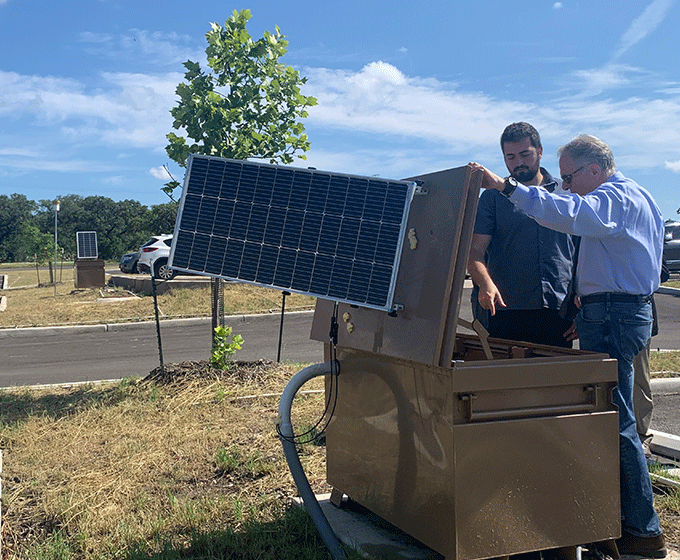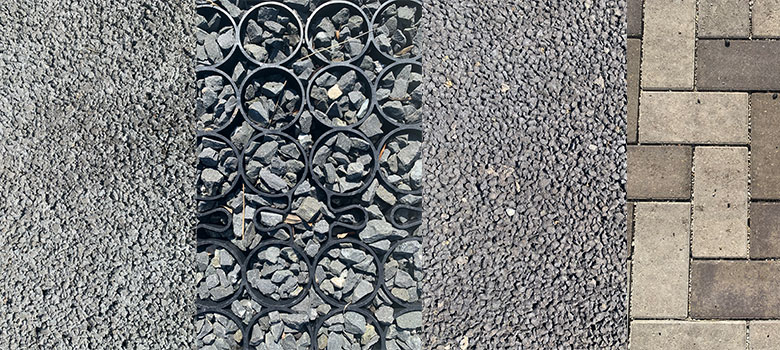
Tom Papagiannakis and Jose Brasil check the solar-powered box at the edge of a permeable lot for measurements of the outflow of rainwater that will be analyzed in the lab
JUNE 13, 2023 — The parking lots at the new, 204-acre Classen-Steubing Ranch Park differ from most conventional lots.
Four types of permeable parking lots were installed at the site as part of the research led by Marcio Giacomoni and Tom Papagiannakis, professors in the Margie and Bill Klesse College of Engineering and Integrated Design’s civil and environmental engineering department.
All four lots use permeable materials that allow precipitation to percolate through rather than run off of the lots. The professors are studying how well these different pavements—permeable asphalt, plastic grid pavers, permeable concrete and permeable interlocking concrete pavers— improve water quality.
“The location was a natural choice,” said Papagiannakis. “It sits above the Edwards Aquifer Recharge Zone. In essence, it’s a UTSA open water quality lab.”
The Edwards Aquifer is the major water source for the residents of South Central Texas. Funded by the City of San Antonio’s 2015 Edwards Aquifer Protection Program Proposition 1 Venue Tax and administered by the San Antonio River Authority, the project also aims to reduce storm water runoff and mitigate surface temperatures in recharge zones—leveraging sustainable solutions for water.
Researchers will evaluate collected rainwater for suspended solids, heavy metals, bacteria and metals emitted from vehicles. Solar-powered boxes sit at the edge of each lot to measure the outflow of water that will be analyzed in the lab.
The team has already collected data to study the water quality before the park was developed and how the water fared during construction. They’ll compare the two datasets alongside new water samples infiltrated through the permeable surface lots to measure how the materials help mitigate pollution.
“Another goal is to enhance public perception of sustainable solutions for stormwater management. We thought it would align really well, having these parking lots at a park so that the community learns about sustainable stormwater management,” Giacomoni said.
While the main datasets focus on evaluating water quality, researchers will also study the cooling effects of the permeable lots and how they treat stormwater runoff and offset flash floods.
Data will also be integrated into the academic curriculum, Giacomoni pointed out, giving UTSA students insight into how to incorporate sustainability into infrastructure.

The four permeable materials used for the parking lot allow precipitation to percolate through rather than run off of the lots.
Jose Brasil is one of the graduate students contributing to the project.
“Being involved with projects on sustainability enhances our understanding of the real world. It creates this sense that we can be more sustainable in the future while maintaining the structures and functionality that we have today,” Brasil said.
UTSA Today is produced by University Communications and Marketing, the official news source of The University of Texas at San Antonio. Send your feedback to news@utsa.edu. Keep up-to-date on UTSA news by visiting UTSA Today. Connect with UTSA online at Facebook, Twitter, Youtube and Instagram.
Move In To COLFA is strongly recommended for new students in COLFA. It gives you the chance to learn about the Student Success Center, campus resources and meet new friends!
Academic Classroom: Lecture Hall (MH 2.01.10,) McKinney Humanities BldgWe invite you to join us for Birds Up! Downtown, an exciting welcome back event designed to connect students with the different departments at the Downtown Campus. Students will have the opportunity to learn about some of the departments on campus, gain access to different resources, and collect some giveaways!
Bill Miller PlazaJoin us for an intimate evening of cocktails, conversation, and culinary inspiration with Pati Jinich, Emmy-nominated chef and James Beard Award-winning author. Enjoy light bites and signature drinks in the warm, modern setting of Mezquite as Pati connects with guests over her passion for Mexican cuisine and storytelling.
Mezquite Restaurant in Pullman Market, 221 Newell Ave., San Antonio 78215From inspired courses to thoughtful pairings and a rich sense of community, the Ven a Comer Signature Dinner is a night of shared meals, shared stories, and unforgettable flavor.
Stable Hall (Pear Brewery), 307 Pearl Pkwy, San Antonio 78215Come and celebrate this year's homecoming at the Downtown Campus with food, games, giveaways, music, and more. We look forward to seeing your Roadrunner Spirit!
Bill Miller PlazaThe University of Texas at San Antonio is dedicated to the advancement of knowledge through research and discovery, teaching and learning, community engagement and public service. As an institution of access and excellence, UTSA embraces multicultural traditions and serves as a center for intellectual and creative resources as well as a catalyst for socioeconomic development and the commercialization of intellectual property - for Texas, the nation and the world.
To be a premier public research university, providing access to educational excellence and preparing citizen leaders for the global environment.
We encourage an environment of dialogue and discovery, where integrity, excellence, respect, collaboration and innovation are fostered.